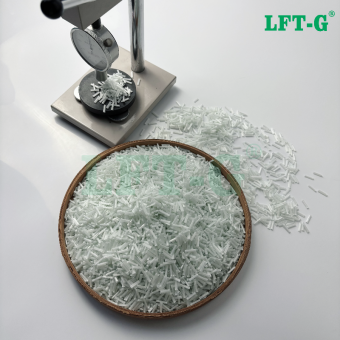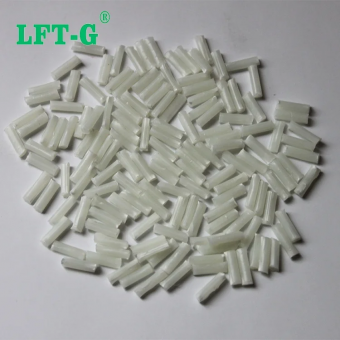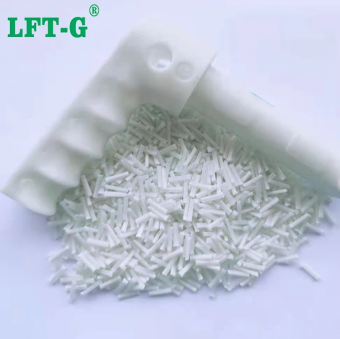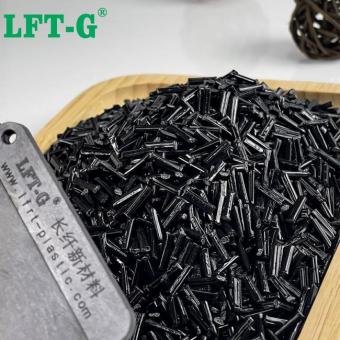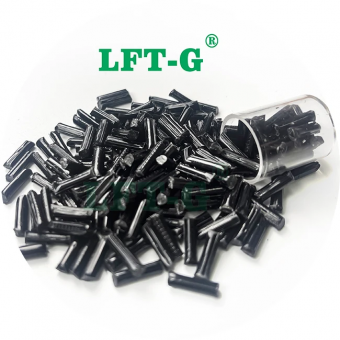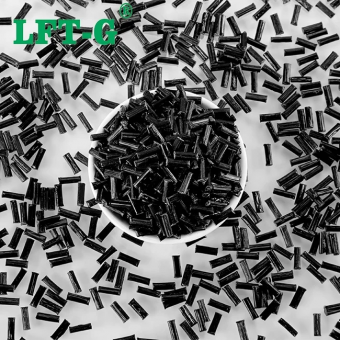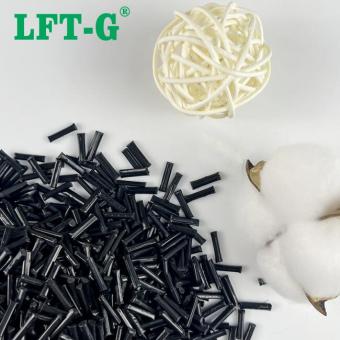-
LFT-G® Polyamide 66 Long Carbon Fiber Filled Compounds Injection molding pelletsWhat is LFT Materials? LFT long fiber reinforced thermoplastic engineering materials,compared to ordinary short fiber reinforced thermoplastic materials (fiber length is less than 1-2 mm), the LFT process produces thermoplastic engineering material's fibers in lengths of 5-25 mm. The long fibers are impregnated with the resin through a special mold system to obtain long strips that are fully impregnated with the resin ,and then cut to the length as required. The most used base resin is PP, by PA6, PA66, PPA,PA12,MXD6,PBT, PET,TPU,PPS, LCP,PEEK, etc. Conventional fibers include glass fiber, carbon fiber,special fibers include basalt fiber and quartz fiber, etc. Depending on the end use, the finished products can be used for injection molding,extrusion, molding, etc., or directly used for plastic instead of steel and thermoset products. Long carbon fiber reinforced composites can solve your problems when other methods of reinforced plastics do not provide the performance you need or if you want to replace metal with plastic. Long carbon fiber reinforced composites can cost-effectively reduce the cost of goods and effectively improve the mechanical properties of engineering polymer. Long fibers can be uniformly distributed inside the product to form a network skeleton, thus improving the mechanical properties of the material product. What is Polyamide 66 Long Carbon Fiber Reinforcement? Nylon 6,6, also written as nylon 6-6, nylon 66, or nylon 6/6, is a more crystalline version of nylon 6. It is also referred to as polyamide 66 or PA 66. It has improved mechanical properties due to its more ordered molecular structure. Nylon 66 for machining has improved temperature resistance and lower rates of water absorption when compared to standard nylon 6. The advantages of nylon 6,6 are that the yield strength is higher than nylon 6 and nylon 610. It has high strength, toughness, rigidity, and low coefficient of friction in a wide temperature range. In addition, it is oil resistant and resistant to chemical reagents and solvents. However, PA66 has strong hygroscopicity and poor dimensional stability, which limits its application. In order to obtain nylon 66 engineering material with higher strength, it should be modified by carbon fiber reinforcement. The mechanical properties of long carbon fiber reinforced nylon 66 (LCFR-PA66) are obviously better than those of short carbon fiber reinforced nylon 66 (SCFR-PA66), and the molding processing performance is also better. It can be molded by various molding methods such as injection molding and compression molding, and complex components can also be formed. Therefore, long carbon fiber reinforced nylon 66 can be widely used in building materials, aerospace, electronic devices, furniture and other fields, especially in the automotive industry application market. The production process of long carbon fiber reinforced nylon 66 is different from that of short carbon fiber reinforced nylon 66. The short carbon fiber reinforced nylon 66 particle is chopped under the friction and shearing of screw and barrel, and the short carbon fiber reinforced nylon 66 particle is obtained with the length of carbon fiber monofilament about 0.5mm. The length of some carbon fiber monofilament in the final product is lower than the critical length of reinforcement, and the carbon fiber is easy to be extracted from the nylon 66 matrix when the product is stressed. The strength of carbon fiber is not fully utilized, and the mechanical properties of the product are not high. Long carbon fiber reinforced nylon 66 has better reinforcement effect and dimensional stability, and the rigidity, tensile, bending, impact resistance and fatigue resistance of the manufactured products are better, and the service life is longer. Q & A Q: Does long glass fiber and long carbon fiber injection have special requirements for injection molding machines and molds? A: There are certainly requirements. especially from the product design structure, as well as the injection molding machine screw nozzle and mold structure injection molding process must consider the requirements of long fiber. Q. The product is easy to brittle, so changing to use long fiber reinforced thermoplastic materials can solve this problem? A: The overall mechanical properties must be improved. The characteristics of long glass fiber and long carbon fiber are the advantages in mechanical properties. It has 1-3 times higher (toughness) than short fiber , and the tensile strength(strength and rigidity) is increased by 0.5-1 times. Q. How to choose the reinforcement method and length of the material when using long fiber reinforced thermoplastic material? A: The selection of materials depend on the requirements of the products. It is necessary to assess how much the content is enhanced and how muc...
- Reinforced thermoplastic resin composites
- Nylon PA 6.6 high strength plastic
- China manufacturer engineering plastic
- CF filament enhanced materials
- long cut fiber instead metal and steel
- high mechanical properties
Tags :
-
Xiamen LFT Polyamide 12 Filled Long Glass Fiber Compounds China manufacturerProduct Name: Polyamide12 long glass fiber composite,Nylon 12 composite Certificated: SGS, 16949 system certificated,MSDS,and so on.
- LFT PA12 LGF long glass fiber virgin grade
- Nylon Fill Long Glass Fiber polyamide 12 high strength
- Nylon 12 Plastic Price high rigidity
- Nylon Composite thermoplastic resin
- Nylon 12 LGF20 instead metal and steel
- Polyamide12 with fiber glass low warpage
Tags :
-
LFT Nylon 12 Polyamide plastic Long Glass Fiber Filled Composites pelletsPA 12 (also known as Nylon 12) is a good general-use plastic with broad additive applications and is known for its toughness, tensile strength, impact strength and ability to flex without fracture. PA 12 has long been used by injection molders due to these mechanical properties.
- High impact strength Injection molding
- modified thermoplastic resin LFRT
- structural parts car gears and bearings
- versatile engineering plastic
- polymers manufactuer of China factory price
- good price plastic resin PA 12
Tags :
-
Xiamen LFT-G Nylon 6 Polyamide 6 composite Long Glass Fiber modified plastic 12mm original colorPA6 material PA6 is one of the most widely used materials in the current field, and PA6 is a very good engineering plastic with balanced and good performance. The raw materials for the manufacture of nylon 6 engineering plastic are extensive and inexpensive, and it is not restricted by the technological monopoly of foreign companies. However, in order to make good use of this inexpensive and excellent material, we must first understand it. Today, we will start with glass fiber reinforced PA6 engineering plastics, because it is the most important category of PA6 engineering plastics. Just like any other engineering plastics, PA6 has advantages and disadvantages, such as high water absorption, low temperature impact toughness and dimensional stability is relatively poor. So engineers will use different methods to make PA6 better, which we call modification. At present, the most common method is to blend and modify PA6 with glass fiber (GF). Today, we will take a look at the mechanical properties of PA6 engineering plastics under the glass fiber GF system for reference and help us select materials. PA6-LGF 1. Influence of glass fiber content on PA6 engineering plastics We can find from the application and experiment that the content index is often one of the biggest influencing factors in fiber reinforced composites. As the glass fiber content increases, the number of glass fibers per unit area of the material will increase, which means that the PA6 matrix between the glass fibers will become thinner. This change determines the impact toughness, tensile strength, bending strength and other mechanical properties of glass fiber reinforced PA6 composites. In terms of impact performance, the increase of glass fiber content will greatly increase the notch impact strength of PA6. Taking long glass fiber (LGF) filling PA6 as an example, when the filling volume increases to 35%, the notch impact strength will increase from 24.8J/m to 128.5J/m. But the glass fiber content is not more is better, short glass fiber (SGF) filling volume reached 42%, the impact strength of the material reached the highest 17.4kJ/㎡, but continue to add will let the gap impact strength showed a downward trend. In terms of bending strength, the increase of the amount of glass fiber will make the bending stress can be transferred between the glass fiber through the resin layer; At the same time, when the glass fiber is extracted from the resin or broken, it will absorb a lot of energy, thus improving the bending strength of the material. The above theory is verified by experiments. The data show that the bending elastic modulus increases to 4.99GPa when the LGF (long glass fiber) is filled to 35%. When the content of SGF (short glass fiber) is 42%, the bending elastic modulus reaches 10410MPa, which is about 5 times that of pure PA6. 2. Influence of glass fiber retention length on PA6 composites The fiber length of the glass fiber also has an obvious effect on the mechanical properties of the material. When the length of the glass fiber is less than the critical length (the length of the fiber when the material has the tensile strength of the fiber), the interface binding area of the glass fiber and the resin increases with the increase of the length of the glass fiber. When the composite material is broken, the resistance of the glass fiber from the resin is also greater, so as to improve the ability to withstand the tensile load. When the length of glass fiber exceeds the critical, the longer glass fiber can absorb more impact energy under impact load. In addition, the end of the glass fiber is the initiation point of crack growth, and the number of long glass fiber ends is relatively less, and the impact strength can be significantly improved. The experimental results show that the tensile strength of the material increases from 154.8MPa to 164.4MPa when the glass fiber content is kept at 40% and the length of the glass fiber increases from 4mm to 13mm. The bending strength and notched impact strength increased by 24% and 28%, respectively. Moreover, the research shows that when the original length of the glass fiber is less than 7mm, the material performance increases more obviously. Compared with short glass fiber, long glass fiber reinforced PA6 material has better appearance warping resistance, and can better maintain mechanical properties under high temperature and humidity conditions. TDS for your reference PA6 can be made into long glass fiber reinforced material by adding 20%-60% long glass fiber according to the characteristics of the product. PA6 with long glass fiber added has better strength, heat resistance, impact resistance, dimensional stability and warping resistance than without glass fiber added. Following TDS show the data of PA6-LGF30. Application PA6-LGF has the largest proportion of applications in the automotive industry, by electronic and electrical applications, and also involving machinery and engineering ...
- PA6 thermoplastic resin materials
- nylon 6 granules
- glass fiber reinforced plastics granules
- long fiber compounds pa6
- Injection molding plastic
- LFT-G reinforced material
Tags :
-
LFT Nylon Polyamide 12 Manufacturer Carbon Fiber filled Compounds special engineering plasticIf you are not sure which PA material is suitable for you, please tell us your needs and our team will provide you with technical support free of charge.
- PA 12 thermoplastic resinforced material
- fiber filling polymer instead of metal steel
- Sample free natural plastic new CFRP
- engineering plastic structural parts
- modified resin good price low MOQ
- automotive fenders Resistant to wear Flexible
Tags :
-
LFT Polylactic Acid Manufacturer Carbon Fiber filled Compounds green materialsPLA (Polylactic Acid) is a semicrystalline thermoplastic polyester. It is derived from renewable sources and is therefore classified as a bioplastic.view more
-
LFT Homopolymer Polypropylene Manufacturer Carbon Fiber filled Compounds green materialsPolypropylene, also known as PP or polypropene, is a polyolefin or saturated polymer.view more
-
LFT Polyamide 6.6 Manufacturer Carbon Fiber filled Compounds green materialsPolyamide, which is also known by the trade name, Nylon, has excellent heat resistant properties, especially when combined with additives and filler materials.view more
-
LFT Polyphenylene Sulfide Manufacturer Carbon Fiber filled Compounds green materialsPPS plastic (polyphenylene sulfide), is a thermoplastic special engineering plastic with excellent comprehensive properties.view more

 e-mail
e-mail English
English français
français Deutsch
Deutsch русский
русский italiano
italiano español
español português
português العربية
العربية 日本語
日本語 한국의
한국의 中文
中文




